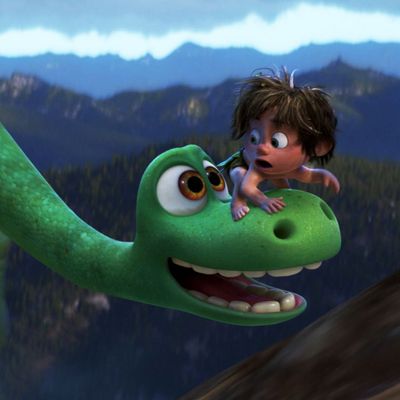
In most live-action movies these days, anything computer-generated is deemed a visual effect. But when the entire movie is computer-generated, as is the case with Pixar’s new film The Good Dinosaur, what does it mean when producer Denise Ream describes it as “Pixar’s biggest effects film to date”?
“That’s a great question,” said Ream, who recently sat down with Vulture and director Peter Sohn to explain how they made the ground-breaking animated film. “Basically, ‘effects’ are water, steam, fire, rain — and probably about 60 percent of the movie had that.”
In other words, if it’s something that a live-action movie would employ to embellish its frame, Pixar probably considers it a visual effect, too. In fact, though the main characters of The Good Dinosaur (including Arlo, the titular dinosaur, and his human companion Spot) are rendered in cartoonish dimensions, the natural world around them is so photo-realistic that it prompted Pixar to innovate in ways that still trip up many live-action films.
“The one thing that we really pushed in this film is the use of volumetric clouds,” said Ream. “Most films do matte-painted clouds, and [effects studio] ILM thought we were crazy to do all volumetric clouds.”
So why was it a priority for Pixar to create something as stubbornly hard to render as a three-dimensional cloud, when most films are content to simply paint a 2-D version? “Because it would create a really beautiful, rich look to have accurate cloud shadows on the environment,” said Sohn. “We could actually then photograph anything in any direction, and that was really important to our cinematographer.”
Just as important was the river that both separates Arlo from his family and eventually guides him back to them. Though great strides have been made over the last decade in animating water, it’s still a time-consuming, expensive effect, and one that Ream worried would be too resource-intensive for the film. Fortunately, just as Pixar’s artists managed to create an entire volumetric cloud library, they built an array of modular river sections that could repeat without the audience ever catching on.
“It was really fun using those things in an emotional way, too, so that they could parallel Arlo’s journey,” said Sohn. “For example, it’s really subtle, but when Arlo’s having a tough time at the beginning, the river is roiling and white-water-y. Later, when he’s getting closer to Spot and closer to nature, the river was like glass, it was peaceful. We would try to do that with every one of the effects layers, simulating it so that it’s alive and connected to what Arlo is experiencing.”
That was especially important because Sohn was determined to make nature itself the film’s primary antagonist. “A lot of those dinosaur movies end with a big carnivore, like a T.rex attacking,” he said. “We wanted to find something that was more emotional, that would still give you the satisfaction of Arlo defeating something.”
Beyond that, Sohn didn’t want to pussyfoot around how dangerous nature can be. Though many animated films will use euphemisms for death, the characters in The Good Dinosaur discuss it openly — and fear it.
“That was something we really fought for and got us excited about this film,” said Sohn. “When we went out on these research trips for the movie, nature would affect me in a way that you couldn’t believe. I’m from New York, and when we’d go to Wyoming or Oregon, you’d see these really beautiful vistas but at the same time the guide would say, ‘That was a landslide over there.’ When we researched rivers, we found that if you got your foot stuck in ten inches of water, you could die. There was danger underneath everything.”
And while the filmmakers were always cautious about making their family film too scary, they wanted to “honor nature” — as well as take cues from how classic animated films treated it, too. “I grew up with movies like Bambi and Pinocchio, and they told things that were truthful and beautiful,” said Sohn. “The big fire at the end of Bambi, how they treat that, like, This is what happens, this is what life has to offer … Wow.”




